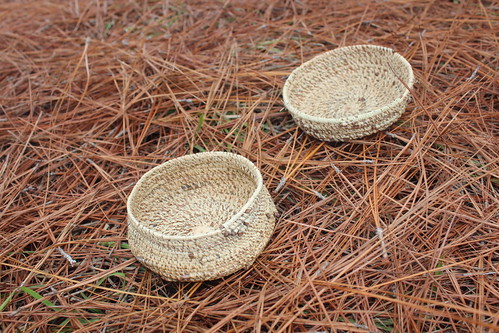
NRCS Soil Conservation Technician Allen Hughes mailed longleaf pine needles from his backyard to Oregon to be used to weave baskets, a Native American tradition across the U.S. Photo: Justin Fritscher, NRCS.
The 567 federally-recognized Native American Tribes are unique in their own way—from their languages and family structure, to their clothing and food. Tribes are working hard to revive their roots to help reconnect their heritage to the land, rekindle their spiritual bonds and cultural traditions, and raise awareness amongst future generations; especially tribal youth in line to inherit the land.
USDA’s Natural Resources Conservation Service (NRCS) works with the tribes like the Choctaw Indians, comprised of nearly 10,000 members across the United States, to farm and harvest hickory king corn and other heirloom white varieties, and process them to make hominy. Hominy is made from dried corn kernels, but it is expensive to purchase. NRCS provides the tribe with technical assistance to help transform idle land into a hominy-making enterprise–enabling the tribe to provide their own locally-grown, fresh produce, and cut their expenses by growing the corn.
NRCS continues its commitment to help revive important tribal traditions with the Puget Salish Tribe, using overlooked resources rooted in the longleaf pine ecosystem. Two NRCS employees, Oregon District Conservationist Andrea Mann and Mississippi Soil Conservation Technician Allen Hughes, coordinated a collection of longleaf pine needles on the Golf Coast, to be mailed for basket weaving on the West Coast. After Mann read about Hughes’ history and dedication to longleaf pine forests, she requested that he mail her and the Salish Tribe the 7- to 18-inch-long pine straws from his backyard.
Basket weaving is one of the oldest Native American traditions, and a tribe’s individuality is shown in the different materials used, weaving methods, and even the basket shapes. Each basket takes 8 to 12 hours to craft. Today’s weaved baskets are used mainly for décor. However, what Mann calls historical “Tupperware,”—valuable to tribes for holding food, water, or personal items—is reappearing.

NRCS District Conservationist Andrea Mann, in Oregon, wove these baskets with longleaf pine needles from Mississippi. Photo: Justin Fritscher, NRCS.
Fearful that an ancient tradition would be lost because of the shortage and limited access to wild river cane used for weaving, the Chitimacha Tribe of Louisiana asked NRCS for assistance. The Chitimacha, a tribe of about 1,300 members, is now planting and harvesting river cane on their reservation to ensure current and future generations of basket weavers have access to their ancestor’s resources.
Committed to supporting Native American Tribes in keeping their cultural traditions alive, NRCS provides conservation programs and technical services to American Indians, Alaska Natives and tribal governments through a network of field offices located on and off tribal lands. Working with the Intertribal Agricultural Council (IAC) and Indian Nations Conservation Alliance (INCA), NRCS has assisted with the establishment of 33 Tribal Conservation Districts.
For more information on conservation opportunities for American Indians, Alaska Natives and tribal governments, please visit NRCS’ Tribal Assistance page.

A member of the Choctaw Indians removes kernels from a corncob, one step in the hominy-making process. Photo: Tim Oakes, NRCS Mississippi.































